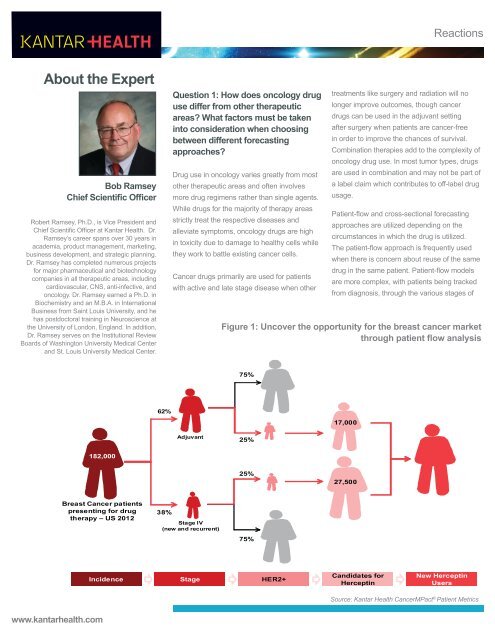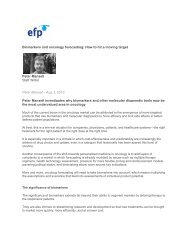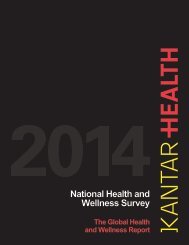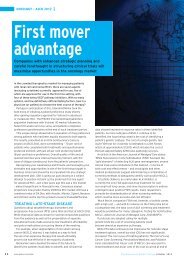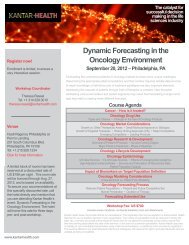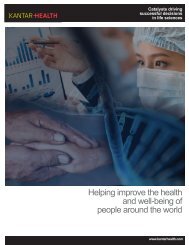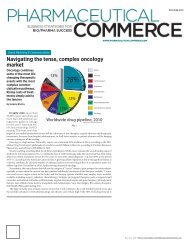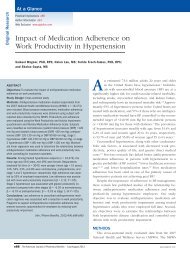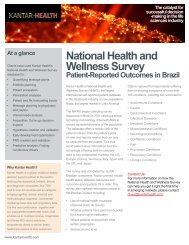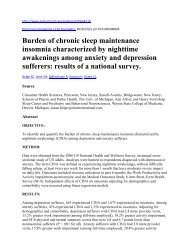Challenges and Caveats in Oncology Forecasting - Kantar Health
Challenges and Caveats in Oncology Forecasting - Kantar Health
Challenges and Caveats in Oncology Forecasting - Kantar Health
Create successful ePaper yourself
Turn your PDF publications into a flip-book with our unique Google optimized e-Paper software.
Reactions<br />
About the Expert<br />
Bob Ramsey<br />
Chief Scientific Officer<br />
Robert Ramsey, Ph.D., is Vice President <strong>and</strong><br />
Chief Scientific Officer at <strong>Kantar</strong> <strong>Health</strong>. Dr.<br />
Ramsey’s career spans over 30 years <strong>in</strong><br />
academia, product management, market<strong>in</strong>g,<br />
bus<strong>in</strong>ess development, <strong>and</strong> strategic plann<strong>in</strong>g.<br />
Dr. Ramsey has completed numerous projects<br />
for major pharmaceutical <strong>and</strong> biotechnology<br />
companies <strong>in</strong> all therapeutic areas, <strong>in</strong>clud<strong>in</strong>g<br />
cardiovascular, CNS, anti-<strong>in</strong>fective, <strong>and</strong><br />
oncology. Dr. Ramsey earned a Ph.D. <strong>in</strong><br />
Biochemistry <strong>and</strong> an M.B.A. <strong>in</strong> International<br />
Bus<strong>in</strong>ess from Sa<strong>in</strong>t Louis University, <strong>and</strong> he<br />
has postdoctoral tra<strong>in</strong><strong>in</strong>g <strong>in</strong> Neuroscience at<br />
the University of London, Engl<strong>and</strong>. In addition,<br />
Dr. Ramsey serves on the Institutional Review<br />
Boards of Wash<strong>in</strong>gton University Medical Center<br />
<strong>and</strong> St. Louis University Medical Center.<br />
Question 1: How does oncology drug<br />
use differ from other therapeutic<br />
areas? What factors must be taken<br />
<strong>in</strong>to consideration when choos<strong>in</strong>g<br />
between different forecast<strong>in</strong>g<br />
approaches?<br />
Drug use <strong>in</strong> oncology varies greatly from most<br />
other therapeutic areas <strong>and</strong> often <strong>in</strong>volves<br />
more drug regimens rather than s<strong>in</strong>gle agents.<br />
While drugs for the majority of therapy areas<br />
strictly treat the respective diseases <strong>and</strong><br />
alleviate symptoms, oncology drugs are high<br />
<strong>in</strong> toxicity due to damage to healthy cells while<br />
they work to battle exist<strong>in</strong>g cancer cells.<br />
Cancer drugs primarily are used for patients<br />
with active <strong>and</strong> late stage disease when other<br />
treatments like surgery <strong>and</strong> radiation will no<br />
longer improve outcomes, though cancer<br />
drugs can be used <strong>in</strong> the adjuvant sett<strong>in</strong>g<br />
after surgery when patients are cancer-free<br />
<strong>in</strong> order to improve the chances of survival.<br />
Comb<strong>in</strong>ation therapies add to the complexity of<br />
oncology drug use. In most tumor types, drugs<br />
are used <strong>in</strong> comb<strong>in</strong>ation <strong>and</strong> may not be part of<br />
a label claim which contributes to off-label drug<br />
usage.<br />
Patient-flow <strong>and</strong> cross-sectional forecast<strong>in</strong>g<br />
approaches are utilized depend<strong>in</strong>g on the<br />
circumstances <strong>in</strong> which the drug is utilized.<br />
The patient-flow approach is frequently used<br />
when there is concern about reuse of the same<br />
drug <strong>in</strong> the same patient. Patient-flow models<br />
are more complex, with patients be<strong>in</strong>g tracked<br />
from diagnosis, through the various stages of<br />
Figure 1: Uncover the opportunity for the breast cancer market<br />
through patient flow analysis<br />
75%<br />
62%<br />
17,000<br />
Adjuvant<br />
25%<br />
182,000<br />
25%<br />
27,500<br />
Breast Cancer patients<br />
present<strong>in</strong>g for drug<br />
therapy – US 2012<br />
38%<br />
Stage IV<br />
(new <strong>and</strong> recurrent)<br />
75%<br />
Incidence Stage HER2+<br />
C<strong>and</strong>idates for<br />
Hercept<strong>in</strong><br />
New Hercept<strong>in</strong><br />
Users<br />
Source: <strong>Kantar</strong> <strong>Health</strong> CancerMPact ® Patient Metrics<br />
www.kantarhealth.com


